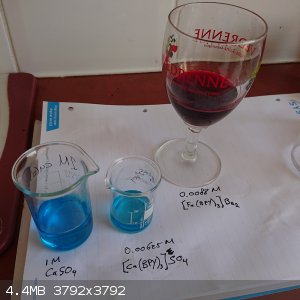Tsjerk
International Hazard
    
Posts: 3022
Registered: 20-4-2005
Location: Netherlands
Member Is Offline
Mood: Mood
|
|
2,2-bipyridine complexes
I made some 2,2-bipyridine complexes. I didn't isolated any of them yet, and I'm not completely sure on how to do that yet, but that is something I
want to in the futher.
Here is a picture: From right to left: 1 molar CuSO4, 0.00625 molar [Cu(BPY)3)2+, and 0.0088 molar
[Fe(BPY)3)2+. The iron complex is in an old wine glass because I ran out of small beakers... I thought it was appropriate.
The copper complex is as the sulfate. For the iron I used some homemade FeSO4 (excess iron and sulfuric acid), to which I added 4 eq. of
Br- as NaBr (100 mM). I can't get the complexes more concentrated than this because I can't get the 2,2-bipyridine to dissolve at
concentrations higher than 0.025 M. Maybe I can play around with protonated bipyridine though, and a bit more concentrated FeSO4 and more concentrated
NaBr.
Tomorrow I want to make the nickel complex with NiSO4. Does anyone know how I could crash out the salts? They seem pretty soluble in water. Would
acetone work? I read the salts are also pretty soluble in alcohol. I would first try to crash out the sulfates, as that would avoid sodium sulfate
contamination.

[Edited on 24-4-2020 by Tsjerk]
|
|
|
Bedlasky
International Hazard
    
Posts: 1219
Registered: 15-4-2019
Location: Period 5, group 6
Member Is Offline
Mood: Volatile
|
|
I think that it is soluble in acetone. It's covalent compound and analogous ruthenium complex is soluble in acetone. But you can try it in test tube scale.
Maybe increasing polarity of solvent will help. Try add saturated NaCl solution, maybe it will work.
|
|
|
numos
Hazard to Others
  
Posts: 269
Registered: 22-2-2014
Location: Pasadena
Member Is Offline
Mood: No Mood
|
|
For these kinds of complexes, as well as phenanthrene type complexes, the magic solvent has always seemed to be acetonitrile. Run the whole reaction
in MeCN, avoiding water altogether. Usually after a few hours of stirring, or leaving undisturbed for a few days, crystals appear.
See: https://doi.org/10.1002/crat.2170310509
They do the nitrate here, I imagine the sulfate should pop out even easier
[Edited on 4-25-2020 by numos]
|
|
|
DraconicAcid
International Hazard
    
Posts: 4278
Registered: 1-2-2013
Location: The tiniest college campus ever....
Member Is Offline
Mood: Semi-victorious.
|
|
Did you ever manage to isolate these compounds?
Please remember: "Filtrate" is not a verb.
Write up your lab reports the way your instructor wants them, not the way your ex-instructor wants them.
|
|
|
Tsjerk
International Hazard
    
Posts: 3022
Registered: 20-4-2005
Location: Netherlands
Member Is Offline
Mood: Mood
|
|
Yes, quite easily but with a lot of patience, I just let them stand to evaporate. The color of the crystalline compounds is not spectacular, but they
redissolve to the original color.
For some reason I added acetone to the Fe(II) complex, this doesn't dissolve the complex but it seem some water of hydration is removed, yielding an
even duller looking solid, more pink than red. But also this redissolves to a nice red.
|
|
|